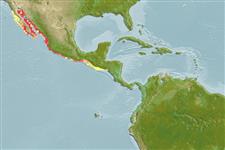Elasmobranchii (sharks and rays) >
Myliobatiformes (Stingrays) >
Urotrygonidae (American round stingrays)
Etymology: Urobatis: Greek,oura = tail + Greek, batis, batidos = a ray (Raja sp.) (Ref. 45335). More on author: Nichols.
Environment / Climate / Range
Ecology
Marine; demersal; depth range 1 - 109 m (Ref. 96339), usually 1 - 35 m (Ref. 9265). Tropical, preferred ?; 31°N - 13°N
Eastern Central Pacific: Gulf of California and scattered localities of Mexico.
Size / Weight / Age
Maturity: Lm ? range ? - ? cm
Max length : 47.5 cm TL male/unsexed; (Ref. 9265)
Found in bays, lagoons and estuaries; also on sandy bottoms near reefs (Ref. 9265). Feeds on crustaceans and small fishes (Ref. 37955), and worms (Ref. 12951). Venomous spine on tail.
Life cycle and mating behavior
Maturity | Reproduction | Spawning | Eggs | Fecundity | Larvae
McEachran, J.D., 1995. Urolophidae. Rayas redondas. p. 786-792. In W. Fischer, F. Krupp, W. Schneider, C. Sommer, K.E. Carpenter and V. Niem (eds.) Guia FAO para Identification de Especies para lo Fines de la Pesca. Pacifico Centro-Oriental. 3 Vols. FAO, Rome. (Ref. 9265)
IUCN Red List Status (Ref. 115185)
CITES (Ref. 94142)
Not Evaluated
Human uses
More information
Common namesSynonymsMetabolismPredatorsEcotoxicologyReproductionMaturitySpawningFecundityEggsEgg development
Age/SizeGrowthLength-weightLength-lengthLength-frequenciesMorphometricsMorphologyLarvaeLarval dynamicsRecruitmentAbundance
ReferencesAquacultureAquaculture profileStrainsGeneticsAllele frequenciesHeritabilityDiseasesProcessingMass conversion
Tools
Special reports
Download XML
Internet sources
